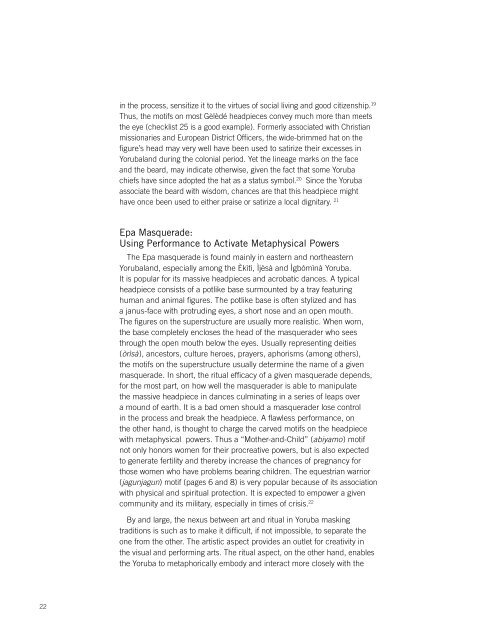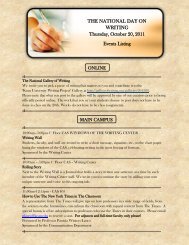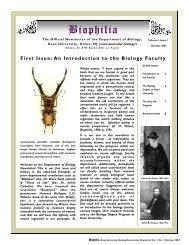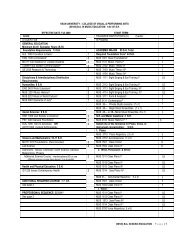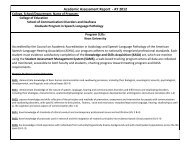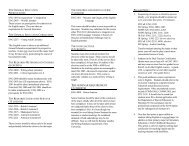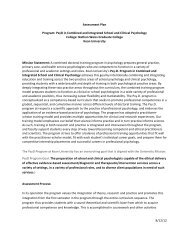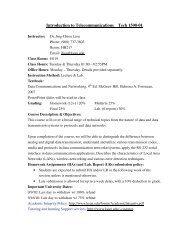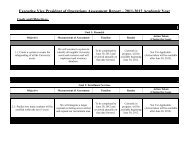Embodying the Sacred in Yoruba Art - Kean University
Embodying the Sacred in Yoruba Art - Kean University
Embodying the Sacred in Yoruba Art - Kean University
You also want an ePaper? Increase the reach of your titles
YUMPU automatically turns print PDFs into web optimized ePapers that Google loves.
22<br />
<strong>in</strong> <strong>the</strong> process, sensitize it to <strong>the</strong> virtues of social liv<strong>in</strong>g and good citizenship. 19<br />
Thus, <strong>the</strong> motifs on most Gèlèdé headpieces convey much more than meets<br />
<strong>the</strong> eye (checklist 25 is a good example). Formerly associated with Christian<br />
missionaries and European District Officers, <strong>the</strong> wide-brimmed hat on <strong>the</strong><br />
figure’s head may very well have been used to satirize <strong>the</strong>ir excesses <strong>in</strong><br />
<strong>Yoruba</strong>land dur<strong>in</strong>g <strong>the</strong> colonial period. Yet <strong>the</strong> l<strong>in</strong>eage marks on <strong>the</strong> face<br />
and <strong>the</strong> beard, may <strong>in</strong>dicate o<strong>the</strong>rwise, given <strong>the</strong> fact that some <strong>Yoruba</strong><br />
chiefs have s<strong>in</strong>ce adopted <strong>the</strong> hat as a status symbol. 20 S<strong>in</strong>ce <strong>the</strong> <strong>Yoruba</strong><br />
associate <strong>the</strong> beard with wisdom, chances are that this headpiece might<br />
have once been used to ei<strong>the</strong>r praise or satirize a local dignitary. 21<br />
Epa Masquerade:<br />
Us<strong>in</strong>g Performance to Activate Metaphysical Powers<br />
The Epa masquerade is found ma<strong>in</strong>ly <strong>in</strong> eastern and nor<strong>the</strong>astern<br />
<strong>Yoruba</strong>land, especially among <strong>the</strong> Èkìtì, Ìjèsà and Ìgbómìnà <strong>Yoruba</strong>.<br />
It is popular for its massive headpieces and acrobatic dances. A typical<br />
headpiece consists of a potlike base surmounted by a tray featur<strong>in</strong>g<br />
human and animal figures. The potlike base is often stylized and has<br />
a janus-face with protrud<strong>in</strong>g eyes, a short nose and an open mouth.<br />
The figures on <strong>the</strong> superstructure are usually more realistic. When worn,<br />
<strong>the</strong> base completely encloses <strong>the</strong> head of <strong>the</strong> masquerader who sees<br />
through <strong>the</strong> open mouth below <strong>the</strong> eyes. Usually represent<strong>in</strong>g deities<br />
(òrìsà), ancestors, culture heroes, prayers, aphorisms (among o<strong>the</strong>rs),<br />
<strong>the</strong> motifs on <strong>the</strong> superstructure usually determ<strong>in</strong>e <strong>the</strong> name of a given<br />
masquerade. In short, <strong>the</strong> ritual efficacy of a given masquerade depends,<br />
for <strong>the</strong> most part, on how well <strong>the</strong> masquerader is able to manipulate<br />
<strong>the</strong> massive headpiece <strong>in</strong> dances culm<strong>in</strong>at<strong>in</strong>g <strong>in</strong> a series of leaps over<br />
a mound of earth. It is a bad omen should a masquerader lose control<br />
<strong>in</strong> <strong>the</strong> process and break <strong>the</strong> headpiece. A flawless performance, on<br />
<strong>the</strong> o<strong>the</strong>r hand, is thought to charge <strong>the</strong> carved motifs on <strong>the</strong> headpiece<br />
with metaphysical powers. Thus a “Mo<strong>the</strong>r-and-Child” (abiyamo) motif<br />
not only honors women for <strong>the</strong>ir procreative powers, but is also expected<br />
to generate fertility and <strong>the</strong>reby <strong>in</strong>crease <strong>the</strong> chances of pregnancy for<br />
those women who have problems bear<strong>in</strong>g children. The equestrian warrior<br />
(jagunjagun) motif (pages 6 and 8) is very popular because of its association<br />
with physical and spiritual protection. It is expected to empower a given<br />
community and its military, especially <strong>in</strong> times of crisis. 22<br />
By and large, <strong>the</strong> nexus between art and ritual <strong>in</strong> <strong>Yoruba</strong> mask<strong>in</strong>g<br />
traditions is such as to make it difficult, if not impossible, to separate <strong>the</strong><br />
one from <strong>the</strong> o<strong>the</strong>r. The artistic aspect provides an outlet for creativity <strong>in</strong><br />
<strong>the</strong> visual and perform<strong>in</strong>g arts. The ritual aspect, on <strong>the</strong> o<strong>the</strong>r hand, enables<br />
<strong>the</strong> <strong>Yoruba</strong> to metaphorically embody and <strong>in</strong>teract more closely with <strong>the</strong>


